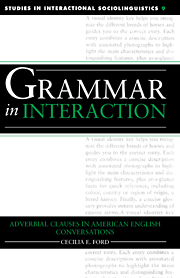Book contents
- Frontmatter
- Contents
- List of illustrations
- List of tables
- Acknowledgements
- Transcription conventions
- 1 Introduction
- 2 Overview of the conversational corpus
- 3 Initial adverbial clauses
- 4 Final versus initial adverbial clauses in continuous intonation
- 5 Final adverbial clauses after ending intonation
- 6 Comparison of clause types and apparent deviations from the general patterns
- 7 Conclusion
- Notes
- References
- Author index
- Subject index
7 - Conclusion
Published online by Cambridge University Press: 09 November 2009
- Frontmatter
- Contents
- List of illustrations
- List of tables
- Acknowledgements
- Transcription conventions
- 1 Introduction
- 2 Overview of the conversational corpus
- 3 Initial adverbial clauses
- 4 Final versus initial adverbial clauses in continuous intonation
- 5 Final adverbial clauses after ending intonation
- 6 Comparison of clause types and apparent deviations from the general patterns
- 7 Conclusion
- Notes
- References
- Author index
- Subject index
Summary
Summary
In this study, I have used the framework of conversation analysis, and the body of findings associated with that approach, to examine the distribution and functions of temporal, conditional, and causal adverbial clauses in a corpus of American English conversation. In the present corpus, in line with findings from prior text-based analyses, discourse-structuring functions are realized through initial adverbial clauses, while final adverbial clauses tend to work more locally in narrowing main clause meaning without creating links or shift points in a larger discourse pattern. I have suggested that the pattern whereby conditional clauses are most likely to be initial, and causal clauses final, is related to an interaction between the inherent meanings of these clauses and the discourse functions those meanings are particularly suitable for serving. The common discourse organizational use of if-clauses is likely related to their hypothetical meaning; they are used to create temporary discourse realities, introducing and forming the background for associated modified material. Causal clauses, which present the sources and precipitating states or events that explain other states or events, are well-suited for appearing after the proposition, to be expanded upon, and for introducing background elaboration. They are especially useful as the vehicles for further explanation when problems arise in interaction. Temporal clauses are used most often in post-verbal position, functioning to ground the situation represented by the verb in time. When temporal clauses are placed initially, they are commonly involved in the structuring of discourse involving sequenced events. Temporal clauses are least common after the preceding clause has been finished with ending intonation.
- Type
- Chapter
- Information
- Grammar in InteractionAdverbial Clauses in American English Conversations, pp. 146 - 150Publisher: Cambridge University PressPrint publication year: 1993



